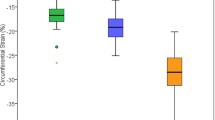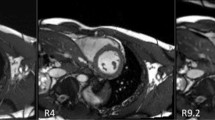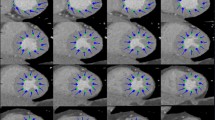Abstract
The purpose of this study was to assess the consistency of semi-automated myocardial strain analysis by prototype software across field strengths, temporal resolutions, and examinations. 35 volunteers (48 ± 13 years; 20% women) and 25 patients (54 ± 12 years; 44% women) without significant cardiac dysfunction underwent cine cardiac magnetic resonance imaging (CMR) at 1.5 T with a temporal resolution of 39.2 msec. 34 subjects also underwent imaging at 3.0 T; 16 had repeat examinations within 14 days; and 9 underwent CMR with temporal resolutions of 12.5 and 39.2 msec on the same day. Prototype heart deformation analysis (HDA) software was used to retrospectively quantify strain from segmented balanced steady state free precession (bSSFP) cinegraphic images. Myocardial contours were automatically generated on short axis images and drawn at end-diastole by two independent reviewers on long-axis images. Contours were automatically propagated throughout the cardiac cycle. Global and regional peak systolic strain were compared across observers, field strengths, temporal resolutions, and examinations. Inter-observer agreement was excellent (ICC > 0.87, p < 0.01). Inter-examination variability was low, ranging from 1.7 (1.0–2.4)% to 2.5 (1.9–3.1)%, except for radial strain: 9.2 (7.6–10.5)%. Most global and regional strain values were not significantly different across field strengths and temporal resolutions (p > 0.05). Normal global peak systolic strain values with HDA were −25.0 (−24.0 to −26.1)% (LV circumferential), 60.5 (55.3 to 65.6)% (LV radial), −22.3 (−20.5 to − 24.0)% (LV longitudinal), and −26.0 (−23.8 to −28.2)% (RV longitudinal). HDA prototype software enabled efficient and consistent quantification of myocardial strain from conventional bSSFP cine CMR data, demonstrating clinical feasibility.



Similar content being viewed by others
References
Mozaffarian D, Benjamin EJ, Go AS, Arnett DK, Blaha MJ, Cushman M, Das SR, de Ferranti S, Despres JP, Fullerton HJ, Howard VJ, Huffman MD, Isasi CR, Jimenez MC, Judd SE, Kissela BM, Lichtman JH, Lisabeth LD, Liu S, Mackey RH, Magid DJ, McGuire DK, Mohler ER, 3rd, Moy CS, Muntner P, Mussolino ME, Nasir K, Neumar RW, Nichol G, Palaniappan L, Pandey DK, Reeves MJ, Rodriguez CJ, Rosamond W, Sorlie PD, Stein J, Towfighi A, Turan TN, Virani SS, Woo D, Yeh RW, Turner MB, American Heart Association Statistics C, Stroke Statistics S (2016) Heart disease and stroke statistics-2016 update: a report from the American heart association. Circulation 133 (4):e38–e360. doi:10.1161/CIR.0000000000000350
Cheung YF (2012) The role of 3D wall motion tracking in heart failure. Nat Rev Cardiol 9(11):644–657. doi:10.1038/nrcardio.2012.128
Collins JD (2015) Global and regional functional assessment of ischemic heart disease with cardiac MR imaging. Radiol Clin of North Am 53 (2):369–395. doi:10.1016/j.rcl.2014.11.001
Gotte MJ, Germans T, Russel IK, Zwanenburg JJ, Marcus JT, van Rossum AC, van Veldhuisen DJ (2006) Myocardial strain and torsion quantified by cardiovascular magnetic resonance tissue tagging: studies in normal and impaired left ventricular function. J Am Coll Cardiol 48(10):2002–2011. doi:10.1016/j.jacc.2006.07.048
Nahum J, Bensaid A, Dussault C, Macron L, Clemence D, Bouhemad B, Monin JL, Rande JL, Gueret P, Lim P (2010) Impact of longitudinal myocardial deformation on the prognosis of chronic heart failure patients. Circ Cardiovasc Imaging 3 (3):249–256. doi:10.1161/CIRCIMAGING.109.910893
Stanton T, Leano R, Marwick TH (2009) Prediction of all-cause mortality from global longitudinal speckle strain: comparison with ejection fraction and wall motion scoring. Circ Cardiovasc Imaging 2 (5):356–364. doi:10.1161/CIRCIMAGING.109.862334
Shah AM, Solomon SD (2012) Myocardial deformation imaging: current status and future directions. Circulation 125(2):e244–e248. doi:10.1161/CIRCULATIONAHA.111.086348
Shehata ML, Cheng S, Osman NF, Bluemke DA, Lima JA (2009) Myocardial tissue tagging with cardiovascular magnetic resonance. J Cardiovasc Magn Reson 11:55. doi:10.1186/1532-429X-11-55
Lamacie MM, Thavendiranathan P, Hanneman K, Greiser A, Jolly MP, Ward R, Wintersperger BJ (2016) Quantification of global myocardial function by cine MRI deformable registration-based analysis: Comparison with MR feature tracking and speckle-tracking echocardiography. Eur Radiol. doi:10.1007/s00330-016-4514-0
Jolly MP, Guetter C, Guehring J (2010) Cardiac segmentation in MR cine data using inverse consistent deformable registration In: IEEE International Symposium on Biomedical Imaging: From Nano to Macro, Rotterdam, 2010. IEEE, pp 484–487
Guetter C, Xue H, Chefd’hotel C, Guehring J (2011) Efficient symmetric and inverse-consistent deformable registration through interleaved optimization. In: IEEE International Symposium on Biomedical Imaging: From Nano to Macro, Chicago, IL, 2011. IEEE, pp 590–593
Petitjean C, Rougon N, Cluzel P (2005) Assessment of myocardial function: a review of quantification methods and results using tagged MRI. J Cardiovasc Magn Reson 7(2):501–516
Simpson RM, Keegan J, Firmin DN (2013) MR assessment of regional myocardial mechanics. J Magn Reson Imaging 37(3):576–599. doi:10.1002/jmri.23756
Singh A, Steadman CD, Khan JN, Horsfield MA, Bekele S, Nazir SA, Kanagala P, Masca NGD, Clarysse P, McCann GP (2015) Intertechnique agreement and interstudy reproducibility of strain and diastolic strain rate at 1.5 and 3 Tesla: a comparison of feature-tracking and tagging in patients with aortic stenosis. J Magn Reson Imaging 41(4):1129–1137. doi:10.1002/jmri.24625
Wu L, Germans T, Guclu A, Heymans MW, Allaart CP, van Rossum AC (2014) Feature tracking compared with tissue tagging measurements of segmental strain by cardiovascular magnetic resonance. J Cardiovasc Magn Reson 16:10. doi:10.1186/1532-429X-16-10
Schuster A, Morton G, Hussain ST, Jogiya R, Kutty S, Asrress KN, Makowski MR, Bigalke B, Perera D, Beerbaum P, Nagel E (2013) The intra-observer reproducibility of cardiovascular magnetic resonance myocardial feature tracking strain assessment is independent of field strength. Eur J Radiol 82(2):296–301. doi:10.1016/j.ejrad.2012.11.012
Morton G, Schuster A, Jogiya R, Kutty S, Beerbaum P, Nagel E (2012) Inter-study reproducibility of cardiovascular magnetic resonance myocardial feature tracking. J Cardiovasc Magn Reson 14:43. doi:10.1186/1532-429X-14-43
Schuster A, Stahnke VC, Unterberg-Buchwald C, Kowallick JT, Lamata P, Steinmetz M, Kutty S, Fasshauer M, Staab W, Sohns JM, Bigalke B, Ritter C, Hasenfuss G, Beerbaum P, Lotz J (2015) Cardiovascular magnetic resonance feature-tracking assessment of myocardial mechanics: intervendor agreement and considerations regarding reproducibility. Clin Radiol 70(9):989–998. doi:10.1016/j.crad.2015.05.006
Phatak NS, Maas SA, Veress AI, Pack NA, Di Bella EV, Weiss JA (2009) Strain measurement in the left ventricle during systole with deformable image registration. Med Image Anal 13(2):354–361. doi:10.1016/j.media.2008.07.004
Boldea V, Sharp GC, Jiang SB, Sarrut D (2008) 4D-CT lung motion estimation with deformable registration: quantification of motion nonlinearity and hysteresis. Med Phys 35(3):1008–1018
Marwick TH, Leano RL, Brown J, Sun JP, Hoffmann R, Lysyansky P, Becker M, Thomas JD (2009) Myocardial strain measurement with 2-dimensional speckle-tracking echocardiography: definition of normal range. JACC Cardiovasc Imaging 2 (1):80–84. doi:10.1016/j.jcmg.2007.12.007
Kim D, Gilson WD, Kramer CM, Epstein FH (2004) Myocardial tissue tracking with two-dimensional cine displacement-encoded MR imaging: development and initial evaluation. Radiology 230(3):862–871. doi:10.1148/radiol.2303021213
Neizel M, Lossnitzer D, Korosoglou G, Schaufele T, Lewien A, Steen H, Katus HA, Osman NF, Giannitsis E (2009) Strain-encoded (SENC) magnetic resonance imaging to evaluate regional heterogeneity of myocardial strain in healthy volunteers: Comparison with conventional tagging. J Magn Reson Imaging 29(1):99–105. doi:10.1002/jmri.21612
Hor KN, Gottliebson WM, Carson C, Wash E, Cnota J, Fleck R, Wansapura J, Klimeczek P, Al-Khalidi HR, Chung ES, Benson DW, Mazur W (2010) Comparison of magnetic resonance feature tracking for strain calculation with harmonic phase imaging analysis. JACC Cardiovasc Imaging 3 (2):144–151. doi:10.1016/j.jcmg.2009.11.006
Zhong J, Yu X (2010) Strain and torsion quantification in mouse hearts under dobutamine stimulation using 2D multiphase MR DENSE. Magn Reson Med 64(5):1315–1322. doi:10.1002/mrm.22530
Cho GY, Chan J, Leano R, Strudwick M, Marwick TH (2006) Comparison of two-dimensional speckle and tissue velocity based strain and validation with harmonic phase magnetic resonance imaging. Am J Cardiol 97(11):1661–1666. doi:10.1016/j.amjcard.2005.12.063
Kuijer JP, Marcus JT, Gotte MJ, van Rossum AC, Heethaar RM (2002) Three-dimensional myocardial strains at end-systole and during diastole in the left ventricle of normal humans. J Cardiovasc Magn 4(3):341–351
Feng L, Donnino R, Babb J, Axel L, Kim D (2009) Numerical and in vivo validation of fast cine displacement-encoded with stimulated echoes (DENSE) MRI for quantification of regional cardiac function. Magn Reson Med 62(3):682–690. doi:10.1002/mrm.22045
Hamdan A, Thouet T, Kelle S, Wellnhofer E, Paetsch I, Gebker R, Schnackenburg B, Fahmy AS, Osman NF, Bornstedt A, Fleck E (2009) Strain-encoded MRI to evaluate normal left ventricular function and timing of contraction at 3.0 T. J Magn Reson Imaging 29(4):799–808. doi:10.1002/jmri.21684
Korosoglou G, Youssef AA, Bilchick KC, Ibrahim el S, Lardo AC, Lai S, Osman NF (2008) Real-time fast strain-encoded magnetic resonance imaging to evaluate regional myocardial function at 3.0 Tesla: comparison to conventional tagging. J Magn Reson Imagin 27(5):1012–1018. doi:10.1002/jmri.21315
Schuster A, Morton G, Hussain ST, Jogiya R, Kutty S, Asrress KN, Makowski MR, Bigalke B, Perera D, Beerbaum P, Nagel E (2013) The intra-observer reproducibility of cardiovascular magnetic resonance myocardial feature tracking strain assessment is independent of field strength (vol 82, pg 296, 2013). Eur J Radiol 82(6):1036–1038. doi:10.1016/j.ejrad.2013.02.001
Yingchoncharoen T, Agarwal S, Popovic ZB, Marwick TH (2013) Normal ranges of left ventricular strain: a meta-analysis. J Am Soc Echocardiograph 26(2):185–191. doi:10.1016/j.echo.2012.10.008
Hamdan A, Thouet T, Kelle S, Paetsch I, Gebker R, Wellnhofer E, Schnackenburg B, Fahmy AS, Osman NF, Fleck E (2008) Regional right ventricular function and timing of contraction in healthy volunteers evaluated by strain-encoded MRI. J Magn Reson Imagin 28(6):1379–1385. doi:10.1002/jmri.21526
Edvardsen T, Detrano R, Rosen BD, Carr JJ, Liu K, Lai S, Shea S, Pan L, Bluemke DA, Lima JA (2006) Coronary artery atherosclerosis is related to reduced regional left ventricular function in individuals without history of clinical cardiovascular disease: the Multiethnic Study of Atherosclerosis. Arterioscler Thromb Vasc Biol 26(1):206–211. doi:10.1161/01.ATV.0000194077.23234.ae
Kramer CM, Malkowski MJ, Mankad S, Theobald TM, Pakstis DL, Rogers WJ Jr (2002) Magnetic resonance tagging and echocardiographic response to dobutamine and functional improvement after reperfused myocardial infarction. Am Heart J 143(6):1046–1051
Castillo E, Osman NF, Rosen BD, El-Shehaby I, Pan L, Jerosch-Herold M, Lai S, Bluemke DA, Lima JA (2005) Quantitative assessment of regional myocardial function with MR-tagging in a multi-center study: interobserver and intraobserver agreement of fast strain analysis with Harmonic Phase (HARP) MRI. J Magn Reson Imagin 7(5):783–791
Paetsch I, Foll D, Kaluza A, Luechinger R, Stuber M, Bornstedt A, Wahl A, Fleck E, Nagel E (2005) Magnetic resonance stress tagging in ischemic heart disease. Am J Phys Heart CircPhysiol 288(6):H2708–H2714. doi:10.1152/ajpheart.01017.2003
Ersboll M, Valeur N, Mogensen UM, Andersen MJ, Moller JE, Velazquez EJ, Hassager C, Sogaard P, Kober L (2013) Prediction of all-cause mortality and heart failure admissions from global left ventricular longitudinal strain in patients with acute myocardial infarction and preserved left ventricular ejection fraction. J Am Coll Cardiol 61(23):2365–2373. doi:10.1016/j.jacc.2013.02.061
Lin K, Collins JD, Lloyd-Jones DM, Jolly MP, Li D, Markl M, Carr JC (2016) automated assessment of left ventricular function and mass using heart deformation analysis: initial experience in 160 older adults. Acad Radiol 23(3):321–325. doi:10.1016/j.acra.2015.10.020
Lin K, Collins JD, Chowdhary V, Markl M, Carr JC (2016) Heart deformation analysis: measuring regional myocardial velocity with MR imaging. Int J Cardiovasc Imaging 32(7):1103–1111. doi:10.1007/s10554-016-0879-z
Lin K, Meng L, Collins JD, Chowdhary V, Markl M, Carr JC (2016) Heart deformation analysis: the distribution of regional myocardial motion patterns at left ventricle. Int J Cardiovasc Imaging. doi:10.1007/s10554-016-1005-y
Lin K, Collins JD, Chowdhary V, Markl M, Carr JC (2016) Heart deformation analysis for automated quantification of cardiac function and regional myocardial motion patterns: A proof of concept study in patients with cardiomyopathy and healthy subjects. Eur J Radiol 85(10):1811–1817. doi:10.1016/j.ejrad.2016.08.005
Acknowledgements
The authors would like to thank Marisol Bello, Griselda Herrera, and Rebecca Ditch for their support coordinating and acquiring the MR imaging for this study.
Author information
Authors and Affiliations
Corresponding author
Ethics declarations
Conflict of interest
Authors MPJ and BSS are full-time employees of Siemens Medical Solutions USA, Inc. No other authors have conflicts of interest relevant to this investigation.
Ethical approval
All procedures performed in accordance with the ethical standards of an Institutional Review Board (STU: 00074604) and 1964 Helsinki declaration and its later amendments.
Informed consent
Informed consent was obtained from all prospectively recruited volunteers and waived for retrospective review of patient data.
Rights and permissions
About this article
Cite this article
Keller, E.J., Fang, S., Lin, K. et al. The consistency of myocardial strain derived from heart deformation analysis. Int J Cardiovasc Imaging 33, 1169–1177 (2017). https://doi.org/10.1007/s10554-017-1090-6
Received:
Accepted:
Published:
Issue Date:
DOI: https://doi.org/10.1007/s10554-017-1090-6




